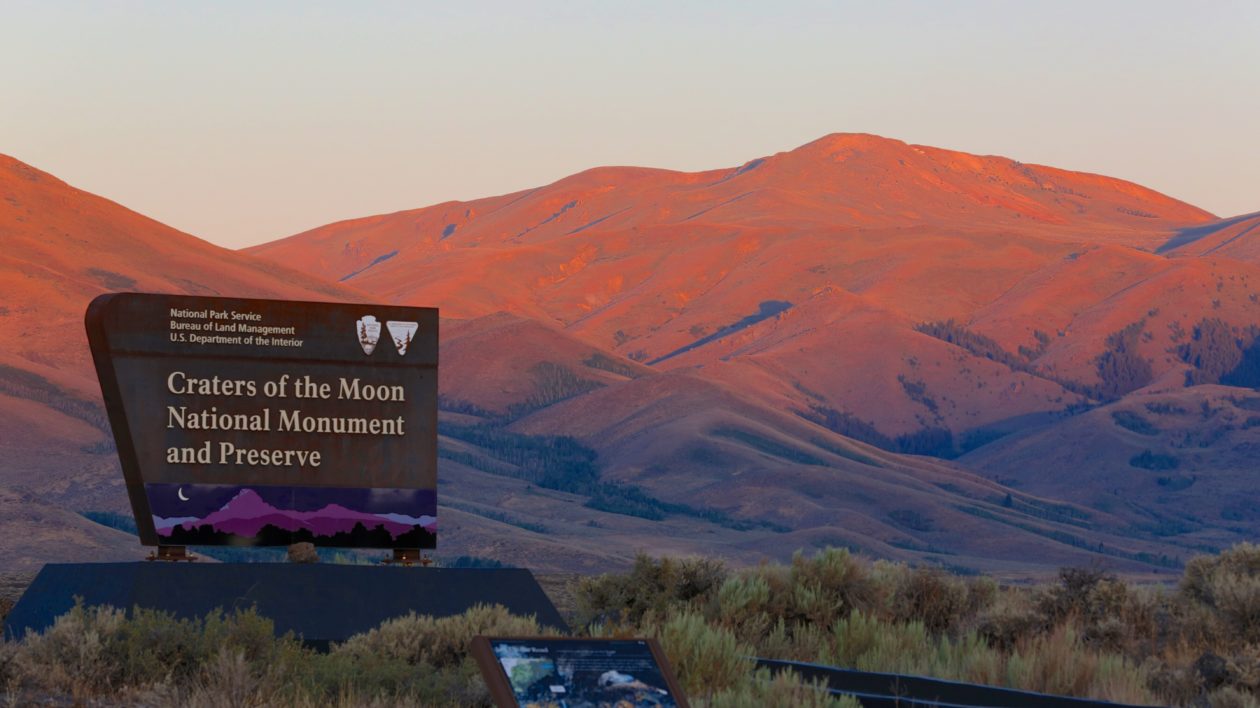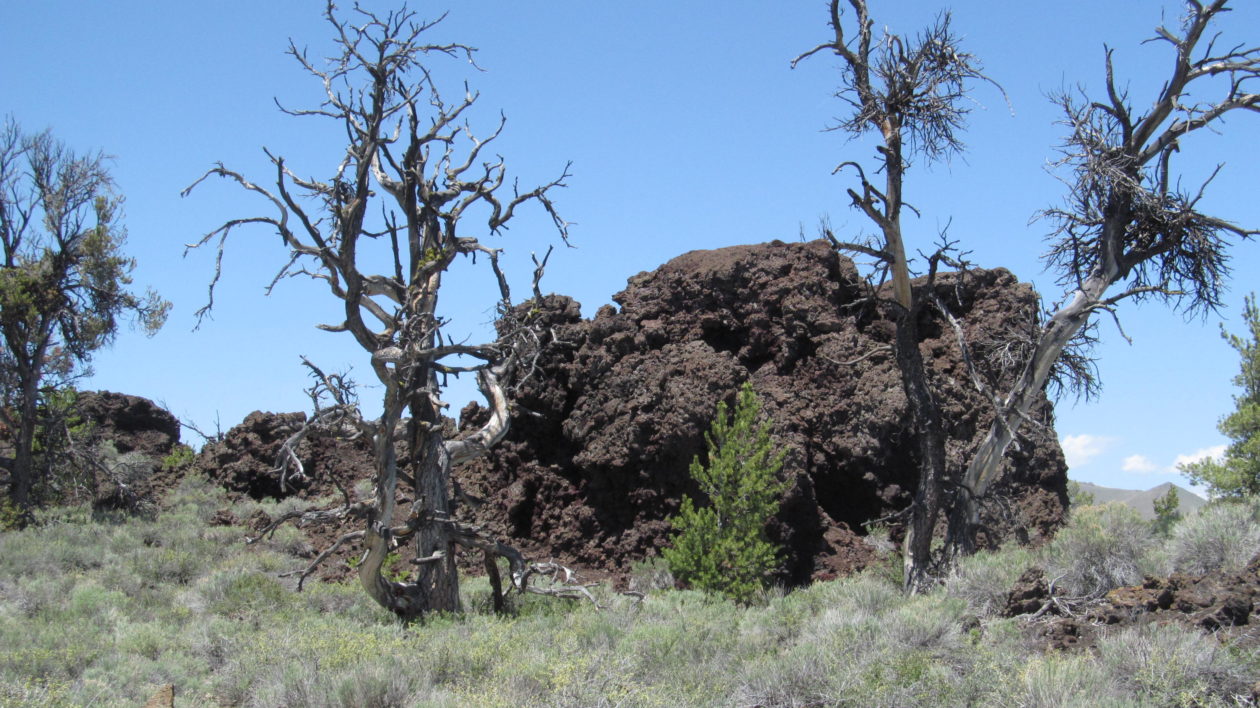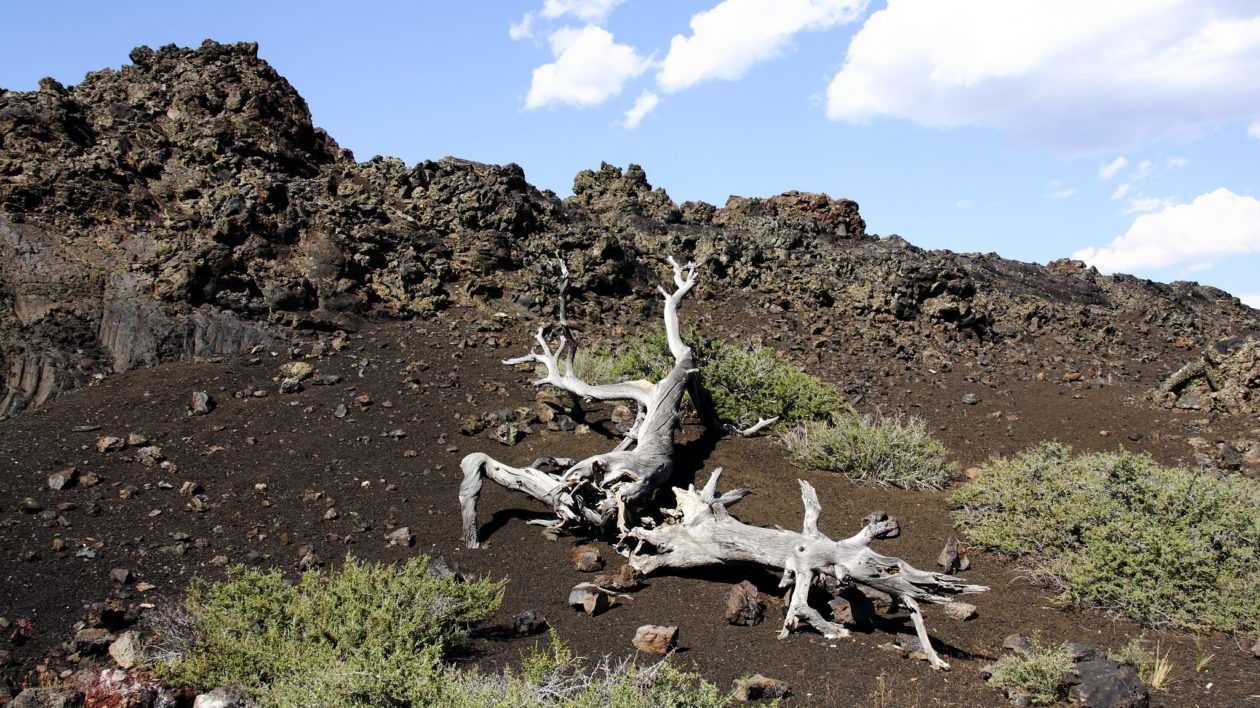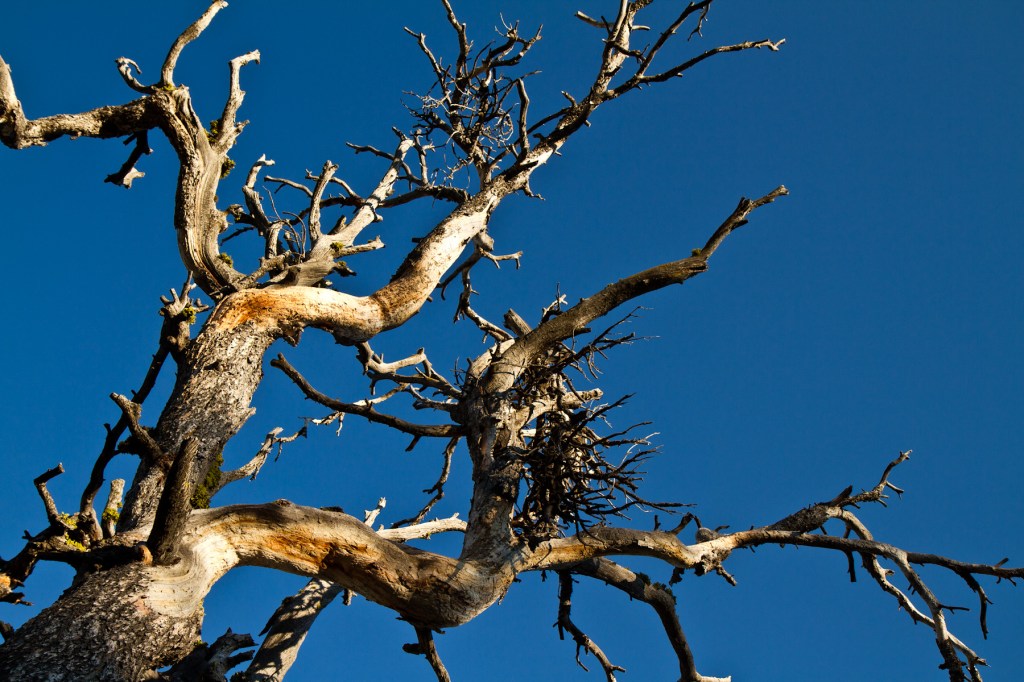In the 1960s, park managers cut and poisoned more than 6,000 trees at Craters of the Moon National Monument in southcentral Idaho. The trees were not invasive species. They posed no threat to visitor safety.
The National Park Service justified this management as a way to protect forest health.
In reality, it was done because the trees were ugly.
Think conservation is always rational and science-based? Think again. Often, it’s based simply on aesthetics, on what we consider beautiful and what we consider ugly.
The trees surviving on the flowing lava fields of the Snake River plain are strong testament to that.
Walking on the Moon
By almost any standard, Craters of the Moon is a surreal, bizarre landscape, one shaped by millennia of lava flows. The easiest way to explore the park is to drive the loop road and stop at the various hiking trails along the way. This will bring you up close to cinder cones, lava tubes and lava caves, a geological wonderland.
As you gaze across all that lava, your first impression might be that this is an inhospitable and barren landscape. Look again. As the saying goes, life finds a way. Pikas, more commonly associated with high-alpine habitats, thrive in this seemingly harsh place. They’re darker in color here, the better to blend in with lava rock, and use the crevices to escape the heat.
Clark’s nutcrackers fly overhead and yellow-bellied marmots whistle from the cinder cones. A species of lava tube beetle is found nowhere else on earth. And where enough water and soil have accumulated in the lava, trees grow.

One of the most common trees here is the limber pine. As the National Park Service notes, “It competes poorly with other tree species and typically grows on dry sites where few other trees can survive.” Dry sites like Craters of the Moon.
Limber pines grow slowly at the monument. They are a striking sight as they cling to life in small spaces between rubble and rock. The National Park Service has long prioritized protecting these trees.
Enter the parasite.
The dwarf mistletoe is a parasitic plant that relies on limber pine for water and nutrients. When a pine is infected with the mistletoe, the parasite diverts water and nutrients away from the tree. The tree’s growth slows and eventually it will die (but this can take decades).
At the infection sites, the mistletoe causes dense branching of the pines. This branching is commonly known as witches’ broom. An infected tree thus looks gnarled and disfigured.
Pause to consider dwarf mistletoe. It’s a parasite. It causes disfigurement in trees. And kills them.
Parasites are bad. Disfigured trees are bad. Dead trees are worse. Right?
Right?

Aesthetics and Conservation
Let’s look again at dwarf mistletoe. It is a native plant. The limber pine and dwarf mistletoe evolved together, a relationship shaped over millennia. And yes, the parasite eventually kills the host, but that is true of many complex ecological relationships.
Dwarf mistletoe can make a tree more susceptible to other, non-native pests. But that’s not really why park managers killed off 6,000 limber pines with witches’ brooms.
They killed them because those pines didn’t conform to a certain standard of how a tree “should” look. They did it based on aesthetics. On values.
Conservation is fundamentally a values-driven enterprise. It’s true that science plays a critical role; this site is dedicated to the ways science can and should influence conservation. Science can tell us if a conservation action is effective. It can tell us if a species is threatened, or what forests hold the most species, or where migration corridors will face barriers. Science can even tell us how to most effectively kill a bunch of trees with witches’ broom.

But the “why” exists largely in the realm of values. And there are times when it is necessary to reexamine values. For a book-length examination of this nexus of values and conservation, I highly recommend Emma Marris’s provocative Wild Souls: Freedom and Flourishing in the Non-Human World. I disagree with the author on several key points, but it’s one of those books that asks you to look at your own values, something every conservationist should do.
I value biodiversity. Biodiversity protection is also core to The Nature Conservancy’s mission. I’m going to guess, since you’re reading this blog, that you hold that same value.
If we value the diversity of life on earth, shouldn’t we value all species, not just the cute and charismatic ones?
And yet, we all know on some level that aesthetics plays a big role in what we conserve. Giant pandas and elephants get the love. Beetles and slugs? Not so much.
In fact, several published studies have shown that “ugly” animals get less conservation attention.
National parks are a reflection of values, too. And there has been no shortage of weird ideas that were a reflection of human values. In Yellowstone, to take a high-profile example, managers at one point eradicated wolves. They offered bear feeding “shows” at Old Faithful. They stocked non-native game fish on top of native wildlife to “improve” fishing. All of these activities were cloaked in scientific language. But they were all driven by values. And now, after reevaluation, those activities are no longer practiced.
A tree with gnarled branches may not be the postcard-perfect image we have of a national park tree. But that doesn’t mean it’s “ugly.”

The Problem with Ugly
One of the many problems with conservation based on aesthetics is that it is rooted in a very narrow definition of what’s beautiful, usually the one held by those of European descent. It’s not universal or objective.
The Shoshone and Bannock Tribal lands include what we now call Craters of the Moon. They have lived there for 10,000 years or more. They never controlled dwarf mistletoe. For that matter, the lava field is not a “weird” or “bizarre” landscape for them. It’s home.
So often, the European worldview labels species as “bad” or “ugly” as if these are objective. But they’re not. Terms like “trash birds” and “trash fish” – used by people who ostensibly love nature – have no scientific definition. They’re unhelpful value judgments, pure and simple.
We may think of parasites as being a clear-cut case of being “bad,” but the reality is that parasite/host relationships have evolved into complex relationships, just as predator and prey have. A witches’ broom is no more “unnatural” than a wolf hunting an elk in Yellowstone.

To the National Park Service’s immense credit, they are quite open about past mistakes and also about the complexities of conservation. At Craters of the Moon National Monument, interpretive signs tell the story of the park’s earlier efforts to kill limber pines “infected” with dwarf mistletoe.
“These park managers tried to make nature conform to their vision of what was beautiful or ‘good,’” one sign reads. “They did not take into consideration that limber pine and mistletoe are both native plants; witches’ broom is born of a longstanding relationship between them.”
It continues: “To preserve park scenery, park managers had cut down park resources. A value judgment about witches’ broom – that it is unsightly, ugly, ‘bad’ – caused the death of these trees.”
The National Park Service, with a mission that includes protecting ecological relationships and biodiversity, no longer kills trees infected with dwarf mistletoe.

Appreciation for Witches’ Broom
Think a creature or plant is ugly? Take another look.
Seriously. Take another look.
I’m heartened that a new generation of conservationists and science communicators is building support for underappreciated creatures. It works. My son sees animals that were once considered “ugly” – snakes and suckers, spiders and mole rats – and all he sees is coolness.
It can be hard to see – actually see – something that we’ve been conditioned to think of as “ugly.” But look again, and you may see a life form superbly adapted to its environment. Something cool. Something worth preserving.
On a recent visit to Craters of the Moon, my family took an excellent ranger-led night hike around a monument trail. Witches’ broom lined the trail. As the moon rose, we paused to look at the gnarled limbs.
No one saw anything ugly. They saw the twisted limbs bathed in moonlight. A tree growing out of lava: nothing less than the perfect embodiment of this special landscape.




Well, the post-pandemic years were challenging for me, so I am just now getting around to reading this. Thank you for reposting this. It is a beautiful story that explores the way unquestioned values can follow us into our relationships with unfamiliar places (and people and cultures). The European settlers who migrated to the new world did the same thing: Cut down trees and straightened rivers to make it look more like England. A westerner, I live in northern New England now, and there are efforts to give the land some space. But the trees are different, and the rivers only regained their rightful channels when tropical storm Irene helped them.
I grew up in a place similar in some ways to the Craters of the Moon, and watched as people tried to make it fit their sense of how it should be: like their version of a city. It didn’t work, of course: it became sprawl. As much as I miss the west, if I get to go back west, it won’t be to that valley, which is developed from end to end. Even the madrones are dying because there is no room for young trees to grow. When I visit, I stay with friends who live on traditional land in the mountains: not wild, but in harmony. There, the scrub oaks have their own kind of mistletoe, and we honor it.
A brief note to one commenter: As the article made clear, yes, it is unnatural to try to control the disease by cutting off infected branches. It doesn’t work, for one thing, and it overlooks the fact that the mistletoe is also part of this ecosystem. Look at the part of the article that says this:
“The Shoshone and Bannock Tribal lands include what we now call Craters of the Moon. They have lived there for 10,000 years or more. They never controlled dwarf mistletoe. For that matter, the lava field is not a “weird” or “bizarre” landscape for them. It’s home.”
The last three paragraphs of the article are sheer beauty, and brought tears to my eyes. How I miss those beautiful gnarled old trees, and the landscape they live in.
Annie,
Thank you for your very thoughtful and insightful comment. I agree that people often try to impose their sense of what “beautiful nature” is upon the wild world, whether that is controlling witches’ broom, straightening rivers, stocking non-native trout or eradicating predators. Many people find each on that list to be “good” not recognizing it is merely reflective of their worldviews. If we can step back and learn from natural, healthy landscapes (a difficult task), other paths in conservation become apparent. Thanks again for writing.
Best,
Matt Miller
If the park service wants to stop the trees from dying, then trimming off the mistle-toe branch will help. The mistle-toe spreads with berries and birds depositing them on new trees. If the mistle-toe is controlled by cutting off the infected branches, then more trees will survive. It sounds like the trees are doomed at this park. I guess it is unnatural to try to control the disease by cutting off infected branches.
I enjoyed your article Mr Miller. If only we all could look at situations from different angles and appreciate their beauty.